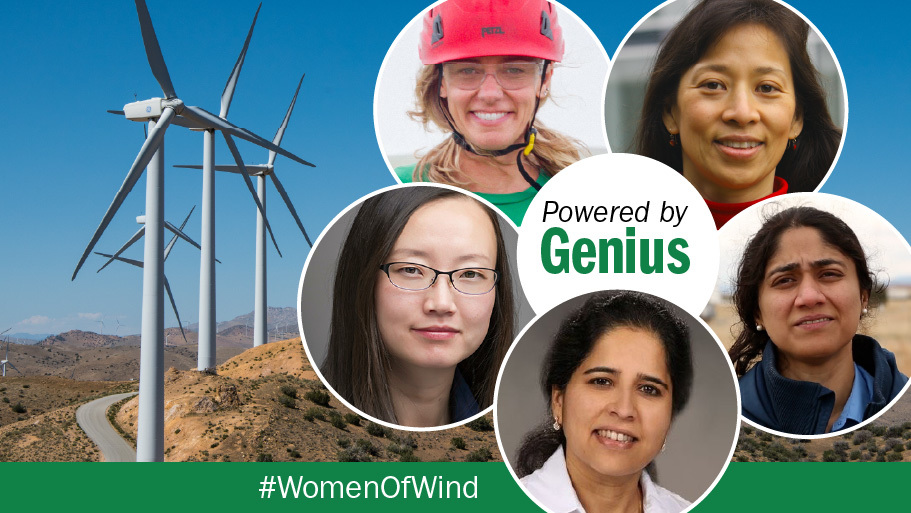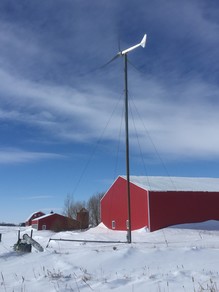 In This Issue
Continue to follow the Wind Energy Technologies Office for the latest news, events, and updates.
News
Today is International Women’s Day—a day to celebrate women’s achievements, raise awareness against bias, and take action for equality.
 In observance of this day, five women working in diverse wind energy roles at national laboratories funded by DOE’s Wind Energy Technologies Office discussed the paths that led them to their current work, their advice for other women interested in working in wind energy, and what the wind and renewable energy industries can do to attract and retain women employees.
Researchers at the U.S. Department of Energy’s (DOE’s) National Renewable Energy Laboratory (NREL) have published an article in Resources, Conservation and Recycling that provides an important perspective on wind turbine waste, recyclability, and reuse.
By calculating the volume of wind turbine blades that will reach the end of their 20-year lifespan in each state by 2050 and comparing this to remaining landfill capacity, the researchers determined that if not recycled or reused, cumulative blade waste would use about 1% of remaining U.S. landfill capacity volume, or 0.2% of landfill mass by 2050. While this represents a small portion of landfill capacity, especially relative to total waste produced in the United States, reducing waste volume is not the only motivation for adopting alternative materials and sustainable end-of-life processes for wind turbine blades. A circular economy ensures that we keep resources in use for as long as possible, extract the maximum value from them while in use, then recover and regenerate products and materials at the end of their service life for use in other contexts. It also reduces the need for virgin materials to build these machines, further reducing environmental impact.
NREL and other DOE national laboratories are researching how changes in turbine design and materials can lead to an improved circular economy for wind turbine materials. For example, using thermoplastic resins—instead of traditional thermoset resins—can improve blade recyclability while enabling longer, lighter-weight, and lower-cost blades.

Distributed wind energy assets provide low-cost power directly to consumers, but in order to enable these turbines to operate most effectively within a microgrid, there is a need for more advanced ways to control them. This allows power companies, businesses, and energy consumers to take advantage of some of the unique technical characteristics of wind energy.
A four-year research initiative, known as MIRACL, for Microgrids, Infrastructure Resilience, and Advanced Controls Launchpad, is working to develop these advanced controls. The research is funded by DOE’s Wind Energy Technologies Office and led by researchers at NREL and Sandia National Laboratories.
Wind turbine controls operate the electrical and mechanical systems of a wind turbine, using a network of sensors connected to a central processing system. The sensors collect data about the conditions surrounding the turbine, such as temperature, wind speed, and voltage on the electric grid. The central processing system receives the data, identifies what action should be taken based on predefined settings or algorithms, and sends signals to the turbine’s mechanical and electrical systems to respond accordingly—such as changing the speed of the rotor or the power coming from the inverter.
The controls-specific research of MIRACL aims to develop and demonstrate improved operational effectiveness of distributed wind turbines and grid-support functions within grid-connected and/or “islanded” microgrids. It will also improve the control and communications compatibility of wind turbines with other distributed energy resources.
To learn more about MIRACL controls-specific research, download the fact sheet.
The North American Wind Energy Academy (NAWEA) is accepting abstracts for the NAWEA/WindTech 2021 Conference, scheduled September 22–24 at the University of Delaware.
This conference is an opportunity for researchers, educators, and industry members to advance collaborative wind energy research. The 2021 conference will explore two main themes: grid integration and the social and environmental science of wind energy development, with the goal of bringing together experts from the full range of disciplines needed to realize this future. NAWEA is developing the conference in partnership with the University of Delaware’s Center for Research in Wind. All abstracts must be submitted by April 16.
|
In Case You Missed It
DOE has announced the 11 teams selected to participate in the 2022 Collegiate Wind Competition, scheduled to take place May 16–19, 2022, at the CLEANPOWER Conference & Exhibition in San Antonio, Texas.
The Collegiate Wind Competition challenges multidisciplinary teams of undergraduate students to develop a wind project plan based on market and siting considerations; raise awareness of wind energy in their local communities; and design, build, and test a model wind turbine against a set of rigorous performance criteria. Participants will integrate academic coursework with hands-on learning, gain valuable wind energy experience, and connect with today’s industry leaders while preparing to enter the wind workforce.
Researchers at DOE’s Sandia National Laboratories are looking at ways to effectively and affordably power homes and businesses using wind energy generated and distributed close to customers through a suite of distributed wind R&D projects, including the DOE-funded Microgrids, Infrastructure Resilience, and Advanced Controls Launchpad (MIRACL) project. To accelerate research from the lab to the field, two teams at Sandia are working with a custom-built distributed wind turbine emulator that combines advanced technologies with state-of-the-art simulation software to study how real wind turbines operate in a variety of power systems designs. These simulations allow researchers to see how wind turbines operate in different weather conditions and with different energy scenarios on distributed power systems, at less cost and risk than conducting such studies at an operating wind plant. For more information on this capability, please contact Brian Naughton (bnaught@sandia.gov).
Funded by DOE’s Wind Energy Technologies Office, the Big Adaptive Rotor project works to enable the next generation of land-based wind turbines with rotors that stretch 206 meters in diameter. Large rotor diameters can increase capacity factors by 10% or more over a typical land-based turbine. While wind turbines with large rotors have advantages, lending truth to the adage that “bigger is better,” the length and width of their blades create transportation challenges.
Learn more about how national laboratory researchers are working to overcome this logistical challenge.
|